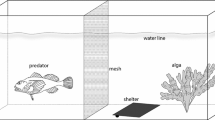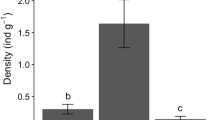Abstract
Small marine invertebrates often use sessile organisms as microhabitats, which can provide food sources and/or serve as refuges from predators. Because of the availability of external food items such as epibionts and detritus in the marine environment, these invertebrates may not depend on the sessile organisms as sole food sources. In this study, I hypothesized that habitat specialization by a marine invertebrate is determined by factors other than food. Results of field surveys off the coast of the Izu Peninsula, on the eastern coast of Japan, showed that, with few exceptions, the distribution of the amphipod Incisocalliope symbioticus was restricted to the octocoral Melithaea flabellifera. When presented with several habitat options, I. symbioticus selected M. flabellifera most frequently, although some individuals chose the octocoral Acabaria japonica. The selection was proximately determined by water-borne cues from M. flabellifera that appear to be unrelated to the octocoral as a food source, since the amphipod preferred detritus to the octocoral. As a chemical refuge, M. flabellifera had an allelopathic effect that deterred fish predation on the exposed epifauna. With regard to octocoral habitat in the study area, I. symbioticus may be restricted to M. flabellifera because this was the only abundant octocoral consistently occurring in shallow water (≤10 m), where predation is intensive. The relationship between I. symbioticus and M. flabellifera was commensal and was ultimately driven by the value of M. flabellifera as a chemical refuge from predation, rather than its food value. This study supports the idea that protection from predators, rather than food utilization, can promote ecological specialization.







Similar content being viewed by others
References
Bayer FM (1981) Key to the genera of Octocorallia exclusive of Pennatulacea (Coelenterata: Anthozoa), with diagnoses of new taxa. Proc Biol Soc Wash 94:902–947
Bernays E, Graham M (1988) On the evolution of host specificity in phytophagous arthropods. Ecology 69:886–892
Coley PD, Bryant JB, Chapin III FS (1985) Resource availability and plant antiherbivore defense. Science 230:895–899
Coll JC (1992) The chemistry and chemical ecology of octocorals (Coelenterata, Anthozoa, Octocorallia). Chem Rev 92:613–631
Cornell HV, Hawkins BA (2003) Herbivore responses to plant secondary compounds: a test of phytochemical coevolution theory. Am Nat 161:507–522
Cronin G, Hay ME, Fenical W, Lindquist N (1995) Distribution, density, and sequestration of host chemical defenses by the specialist nudibranch Tritonia hamnerorum found at high densities on the sea fan Gorgonia ventalina. Mar Ecol Prog Ser 119:177–189
Denno RF, Larsson S, Olmstead KL (1990) Role of enemy-free space and plant quality in host-pant selection by willow beetles. Ecology 71:124–137
Duffy JE, Hay ME (1994) Herbivore resistance to seaweed chemical defense: the roles of mobility and predation risk. Ecology 75:1304–1319
Ehrlich PR, Raven PH (1964) Butterflies and plants: a study in coevolution. Evolution 18:586–608
Feeny P (1970) Seasonal changes in oak leaf tannins and nutrients as a cause of spring feeding by winter moth caterpillars. Ecology 51:565–581
Fox LR, Morrow PA (1981) Specialization: species property or local phenomenon? Science 211:887–893
Franz DR, Mohamed Y (1989) Short-distance dispersal in a fouling community amphipod crustacean, Jassa marmorata Holmes. J Exp Mar Biol Ecol 133:1–13
Guo CC, Hwang JS, Fautin DG (1996) Host selection by shrimps symbiotic with sea anemones: a field survey and experimental laboratory analysis. J Exp Mar Biol Ecol 202:165–176
Harvell CD, Fenical W, Roussis V, Ruesink JL, Griggs CC, Greene CH (1993) Local and geographic variation in the defensive chemistry of a West Indian gorgonian coral (Briareum asbestinum). Mar Ecol Prog Ser 93:165–173
Hay ME, Colburn T, Downing D (1983) Spatial and temporal patterns in herbivory on a Caribbean fringing reef: the effects on plant distribution. Oecologia 58:299–308
Hay ME, Duffy JE, Pfister CA, Fenical W (1987) Chemical defense against different marine herbivores: are amphipods insect equivalents? Ecology 68:1567–1580
Hay ME, Fenical W (1988) Marine plant-herbivore interactions: the ecology of chemical defense. Annu Rev Ecol Syst 19:111–145
Hay ME, Duffy JE, Fenical W (1990) Host-plant specialization decreases predation on a marine amphipod: an herbivore in plant’s clothing. Ecology 71:733–743
Kareiva P (1982) Experimental and mathematical analyses of herbivore movement: quantifying the influence of plant spacing and quality on foraging discrimination. Ecol Monogr 53:261–282
Koh LL, Goh NKC, Tan YW (2000) Chemical and physical defenses of Singapore gorgonians (Octocorallia: Gorgonacea). J Exp Mar Biol Ecol 251:103–115
Koike K, Nishiwaki S (1977) Seasonal change of fish fauna in the Zostera zone in Shimoda Bay and Nabeta Cove, the Izu Peninsula (in Japanese with English abstract). Jpn J Ichthyol 24:182–192
Kumagai NH (2006) Distance effects on patterns and processes of dispersal in an octocoral-associated amphipod. Mar Ecol Prog Ser 321:203–214
Kumagai NH, Aoki MN (2003) Seasonal changes in the epifaunal community on the shallow-water gorgonian Melithaea flabellifera. J Mar Biol Ass UK 83:1221–1222
Kumagai NH, Shinagawa H, Sato T, Tsuchiya Y, Aoki MN (2004) Transplantation of gorgonian octocorals for in situ experimental manipulations. Benthos Res 59:11–19
Lee WY, Macko SA, Ciereszko LS (1981) Toxic effects of cembranolides derived from octocorals on the rotifer Brachionus plicatilis Müller and the amphipod Parhyale hawaiensis (Dana). J Exp Mar Biol Ecol 54:91–96
Maida M, Sammarco PW, Coll JC (1995) Effects of soft corals on scleractinian coral recruitment. I: Directional allelopathy and inhibition of settlement. Mar Ecol Prog Ser 121:191–202
Matsumoto AK (2004) Heterogeneous and compensatory growth in Melithaea flabellifera (Octocorallia: Melithaeidae) in Japan. Hydrobiologia 530/531:389–397
McCullagh P, Nelder JA (1989) Generalized linear models. 2nd edn. Chapman and Hall, New York
Mokady O, Bonar DB, Arazi G, Loya Y (1991) Coral host specificity in settlement and metamorphosis of the date mussel Lithophaga lessepsiana (Vaillant, 1865). J Exp Mar Biol Ecol 146:205–216
Ohsaki N, Sato Y (1994) Food plant choice of Pieris butterflies as a trade-off between parasitoid avoidance and quality of plants. Ecology 75:59–68
O’Neal W, Pawlik JR (2002) A reappraisal of the chemical and physical defenses of Caribbean gorgonian corals against predatory fishes. Mar Ecol Prog Ser 240:117–126
Orth RJ, van Montfrans J (1984) Epiphyte-seagrass relationships with an emphasis on the role of micrograzing: a review. Aquat Bot 18:43–69
Pawlik JR (1993) Marine invertebrate chemical defenses. Chem Rev 93:1911–1922
Poore AGB, Watson MJ, de Nys R, Lowry JK, Steinberg PD (2000) Patterns of host use among alga- and sponge-associated amphipods. Mar Ecol Prog Ser 208:183–196
Price PW, Bouton CE, Gross P, McPheron BA, Thompson JN, Weis AE (1980) Interactions among three trophic levels: influence of plants on interactions between insect herbivores and natural enemies. Ann Rev Ecol Syst 11:41–65
Ritson-Williams R, Shjegstad S, Paul V (2003) Host specificity of four corallivorous Phestilla nudibranchs (Gastropoda: Opisthobranchia). Mar Ecol Prog Ser 255:207–218
Schmitt TM, Hay ME, Lindquist N (1995) Constraints on chemically mediated coevolution: multiple functions for seaweed secondary metabolites. Ecology 76:107–123
Singer MS, Rodrigues D, Stireman III JO, Carrière Y (2004) Roles of food quality and enemy-free space in host use by a generalist insect herbivore. Ecology 85:2747–2753
Sokal RR, Rohlf FJ (1995) Biometry. 3rd edn. Freeman, New York
Sotka EE, Hay ME, Thomas JD (1999) Host-plant specialization by a non-herbivorous amphipod: advantages for the amphipod and costs for the seaweed. Oecologia 118:471–482
Stachowicz JJ, Hay ME (2000) Geographic variation in camouflage specialization by a decorator crab. Am Nat 156:59–71
Steinberg PD, de Nys R, Kjelleberg S (2001) Chemical mediation of surface colonization. In: McClintock JB, Baker BJ (eds) Marine chemical ecology, CRC Press, Boca Raton, pp 355–387
Stoner AW (1980) Abundance, reproductive seasonality and habitat preferences of amphipod crustaceans in seagrass meadows of Apalachee Bay, Florida. Contrib Mar Sci 23:63–77
Tanaka K (2003) Population dynamics of the sponge-dwelling gnathiid isopod Elaphognathia cornigera. J Mar Biol Ass UK 83:95–102
Targett NM, Targett TE, Vrolijk NH, Ogden JC (1986) Effects of macrophyte secondary metabolites on feeding preferences of the herbivorous parrotfish Sparisoma radians. Mar Biol 92:141–148
Thompson JN (1988) Evolutionary ecology of the relationship between oviposition preference and performance of offspring in phytophagous insects. Entomol Exp Appl 47:3–14
Van Dolah RF (1978) Factors regulating the distributions and population dynamics of the amphipod Gammarus palustris in an intertidal salt marsh community. Ecol Monogr 48:191–217
Wahle CM (1983) Regeneration of injuries among Jamaican gorgonians: the roles of colony physiology and environment. Biol Bull 165:778–790
Yoshioka PM, Yoshioka BB (1991) A comparison of the survivorship and growth of shallow-water gorgonian species of Puerto Rico. Mar Ecol Prog Ser 69:253–260
Zimmer RK, Butman CA (2000) Chemical signaling processes in the marine environment. Biol Bull 198:168–187
Zimmerman RR, Gibson R, Harrington J (1979) Herbivory and detritivory among gammaridean amphipods from a Florida seagrass community. Mar Biol 54:41–47
Acknowledgments
I am very grateful to M. N. Aoki for his generous support, critical comments and for the field photograph. I am indebted to Y. Tsuchiya, T. Sato, H. Shinagawa, M. Sakata, and B. Subhan for their assistance with the diving fieldwork. The comments of M. Nakaoka, and two anonymous reviewers greatly improved this manuscript. This research was partly supported by grants-in-aids from the Ministry of Education, Science, Culture and Sports, Japan (no. 18201043). This is contribution number 734 from the Shimoda Marine Research Center, University of Tsukuba. All surveys and experiments complied with current Japanese laws.
Author information
Authors and Affiliations
Corresponding author
Additional information
Communicated by Martin Attril.
Rights and permissions
About this article
Cite this article
Kumagai, N.H. Role of food source and predator avoidance in habitat specialization by an octocoral-associated amphipod. Oecologia 155, 739–749 (2008). https://doi.org/10.1007/s00442-007-0941-6
Received:
Accepted:
Published:
Issue Date:
DOI: https://doi.org/10.1007/s00442-007-0941-6




